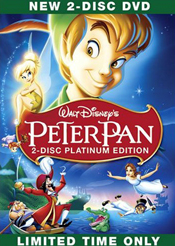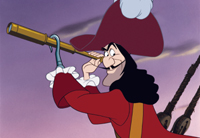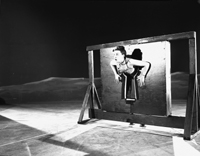Making movies. Enjoying movies. Remembering movies.
|
|
|
|
Related Articles:
|
Posted March 6, 2007 |
|
Walt Disney's "Peter Pan" Sets Sail On DVD |
By
William Kallay

Forget about those
dreadful remakes of the story of “Peter Pan” over the years. They’ve helped
ruin and confuse children on what made Pan so delightful. Steven Spielberg’s
rare misfire, “Hook” (1991) re-imagined Pan as a boring grown-up with
issues. P.J. Hogan’s “Peter Pan” (2003) was an interesting re-telling, but
it was bogged down by heavy handed seriousness and violence. Disney’s own
“Return To Never Land” (2002) was an unnecessary visit to the mythical
island in the sky. “Finding Neverland” (2004) saw Johnny Depp portray author
J.M. Barrie in a moving performance.
I believe that the best interpretation of J.M. Barrie’s children’s
masterpiece was Walt Disney’s 1953 version of “Peter Pan.” The classic tale
is again available on DVD, this time on a 2-disc edition. The film was
originally released on DVD two times, once in 1999, and again in 2002. The
current 2-disc edition is the best, though it does recycle some bonus
material featured on the previous discs.
 |
Disc 1 contains the feature film in full screen (1.33:1), a 5.1 Disney
Enhanced Home Theatre Mix, the original mono soundtrack, and French and
Spanish dubbed soundtracks. There’s an audio commentary by Roy E. Disney,
Kathryn Beaumont (Wendy), Margaret Kerry (Tinker Bell’s live action
reference model), animators Ollie Johnston, Frank Thomas, Marc Davis, Ward
Kimball, Disney historian Jeff Kurti, animation historian John Canemaker,
and film critic Leonard Maltin. This audio commentary was on the previous
DVDs. The bonus features continue with a sneak peek at the new movie “Tinker
Bell,” a Disney song selection link, “Peter’s Playful Prank: Storybook,”
English subtitles and Disney’s array of Sneak Peeks at other theatrical
films and DVDs.
Disc 2 features four sections with individual links to more bonuses. “Music
& More” contains the deleted song, “The Pirate Song.” “Never Land: The Lost
Song” has famed Disney composer Richard M. Sherman discussing his re-working
of a lost song that was written for “Peter Pan.” This leads into Paige
O’Hara’s rendition of the song in a music video. Last in this section is the
teen singing group T-Squad singing “The Second Star To The Right.”
In the “Games &
Activities” section, kids will get a kick out of the “English Read-Along:
Peter Pan,” which features the film with a read-along subtitle. The “Camp
Never Land: Train To Be A Lost Boy” section has three games to keep the
little ones entertained, including “Smee’s Sudoku Challenge,” “Tarrrget
Practice,” and “Tink’s Fantasy Flight.”
“Backstage Disney” is where adult Disney fans will enjoy a number of
behind-the-scenes featurettes about the making “Peter Pan.” “You Can Fly:
The Making Of Peter Pan” has been recycled from the previous DVDs. This is a
enjoyable documentary, though it would’ve been nice if Disney spent a little
extra time to produce an entirely new film. “In Walt’s Words: ‘Why I Made
Peter Pan’” is a reconstruction of Walt as a child seeing “Peter Pan” for
the first time on stage. Directors Ron Clements & John Musker (“The Little
Mermaid) introduce this featurette. “Tinker Bell: A Fairy’s Tale” is a look
at the development of the little pixie as a classic Disney character. “The
Peter Pan That Almost Was” tells how the film might’ve been made had
Disney’s artists taken a different approach. The “Art Galleries” offer an
assortment of photos and art for the most ardent Pan fan. Finally rounding
out this section is “The Peter Pan Story” (1952 Featurette) is another
recycled section from the previous DVDs, but is no less enjoyable.
The last section is much in the line of previous “virtual rides” done on
Disney DVDs in the recent past. “Peter Pan’s Virtual Flight” is somewhat
reminiscent of the famous Peter Pan attractions in Disney’s theme parks.
Except this time, riders can fly from the comfort of their favorite chair
through a computer generated London.
The picture quality of this new DVD set is superb. Digitally restored and
remastered, the picture is steady, free of grain and very sharp & clean.
Unlike the previous 2002 DVD (of which I own), there is no film jitter
(shake) or grain. The result on this new DVD is a very nice and pleasing
picture. It’s not too overly “cleaned” as “Cinderella” appears and seems
more natural in tune with the film’s 1953 look. The film was digitally
restored by John Lowry and his restoration team at DTS Digital Images. His
previous efforts have included other Disney titles like “Cinderella” and
“Lady And The Tramp.” To see this film properly in its original aspect
ratio, and if you have a 16:9 television monitor, it’s best to set the
aspect ratio to 4:3.
 |
Once again, Disney
has done an excellent job in remastering their soundtracks, and “Peter Pan”
is no exception. Sound mixer Terry Porter remastered the sound in 5.1
“Disney Enhanced Home Theatre Mix,” an idea he came up with for “The Lion
King” DVD. Since then, Disney has released many of their titles, including
ones originally recorded and presented in mono sound, in this format. It
gives the home viewer a more immersive sound environment than they would
even hear in a theatre. Thankfully, Porter doesn’t overdue it on his
remixes, and the soundtracks stay very close to the original mix. He’s an
outstanding mixer and should be commended for respecting these Disney works.
The Disney Studio, for many years, and especially on their animated
features, recorded some very good soundtracks in mono sound. As presented on
this DVD, the music is clear and full. As for the mixes, the 5.1 option
plays at 448kbps, while the original mono mix plays at 128kbps. The French
mix plays at 448kpbs, but the Spanish mix plays at 384kpbs. The audio
commentary track plays at 96kpbs. What does this mean for your home theatre
set-up? These all sound very good, despite the digital compression used on
the Dolby Digital soundtracks. There are occasional surround effects used in
the new mix of “Pan,” but they’re unobtrusive and add a little fun to the
movie.
“Peter Pan” was well suited for Disney. The original story was changed a bit
for his animated version of the classic play, but I think Disney’s version
is the most fun. It captured the essence of Pan’s childhood playfulness,
leadership of the Lost Boys, his constant teasing of Captain Hook, his love
for Tinker Bell, and the wonderment the Darling children who dare to
imagine.
Unlike most of the films made after its 1953 release, “Peter Pan” is still
completely entertaining and free of adult point-of-view instilled in later
versions like “Hook” or “Return To Never Land.” Walt Disney’s “Peter Pan”
took the core of the story, never wanting to grow up, only to realize it was
okay to grow up, and stuck with it. The story is told so well that both
children and adults can enjoy the slapstick and fantasy all rolled into a
tight package. The problem with the re-imaginings of the Pan story is that
adults took over and sucked out the fun of being a kid. In “Hook,” Peter Pan
has grown up to be a complete bore, and remains so through most of the
movie. There’s barely any magic to Robin Williams’ Pan. In P.J. Hogan’s
“Peter Pan,” the story is done well, but Captain Hook is entirely too dark,
sinister and violent to enjoy, especially in a story so clearly made for
children. In a children’s story like this, a villain should be fun to watch
and even liked, not feared.
The story of “Pan” really, even though it’s simple, covers a lot of bases.
The ideas of accepting having to grow up, taking responsibility and
realizing kids have to dream is some pretty deep stuff. Disney’s version,
however, doesn’t get too much into that, at least in detail, and plays the
story for fun. One of the best aspects of the “Pan” myth is youth versus
growing up, and this is represented by Peter Pan versus Captain Hook. The
beauty of Disney’s film is that Captain Hook (Hans Conried) is a perfect
nemesis for Peter Pan. He’s a caricature of an adult buffoon who gets easily
frustrated at Pan, a kid who annoys him with his constant antics. Pan knows
this is all a game, except one of the players, Hook, takes things a little
too seriously. Those blasted kids! But isn’t that the magic of the kid
versus adult dynamic? Don’t kids sometimes annoy grown ups, and don’t grown
ups get frustrated with kids with an understanding that kids will be kids?
Isn’t there an underlying admiration between the two camps? Adults may
sometimes wish they were kids again, and kids, well, may wish to be grown
up, and then again, maybe not! Bottom line is that the entire film takes the
Pan myth and has fun with it, never once resorting to being heavy handed.
 |
Disney’s “Peter Pan”
is the best filmed version of the story. I understand that the Mary Martin
television special (1956) was popular in its day and is considered to be a
classic. But it’s Disney’s version which made the story come alive. No
longer confined to a stage, the story really can do things it could never do
before. In the silent film version, and in the Mary Martin special, the
story was still stagy. In Disney’s retelling, both the characters and camera
were free to fly.
I had seen professional stage versions of “Peter Pan” in Los Angeles, one
featuring Sandy Duncan and another featuring Cathy Rigby. Each show was
outstanding, especially when Peter Pan flies into the audience. There’s no
better way of getting an audience of children (and some adults) to say
“Wow!” And one of the highlights of these late-20th Century shows was that
Tinker Bell was not just a spotlight flying about the stage anymore. She was
a laser beam of light that could do tricks that no previous Tinker Bell
could do. But she was no Disney Tinker Bell.
Animator Marc Davis so perfectly designed and brought to life Tinker Bell,
that she’s been a staple in Disney’s character parade since the get-go. He
brought so much personality to her that despite her inability to speak like
a person, an audience could clearly understand her emotions and her
thoughts. This is no doubt in combination with live action model Margaret
Kerry’s brilliant acting as Tinker Bell that combined for a classic
character (as can be seen on the 2nd DVD). Tink, as Peter calls her, is cute
and filled with spunk. She speaks, or rather, chimes, what’s on her mind.
Davis’ drawing of her is splendid, with Tink’s cherubic facial features,
large expressive blue eyes and blond hair bun. I’m not sure if Davis
patterned her hair on the styles of the early-1950s, or on his wife, Alice,
but Tinker Bell is adorable in either capacity.
Almost all of the characters in the Pan story are enjoyable, right down to
most minor characters. Some stand out more than others, but it’s one of
those stories, done as a play, that almost any actor would be happy playing
a minor role. One of my personal favorites has always been Captain Hook. The
Disney animators were correct in exaggerating Hook’s appearance as a stylish
rogue of the high seas who is prone to slapstick. He’s comic fodder for not
only Peter Pan, but for his sidekick, Mr. Smee (Bill Thompson). I don’t know
of any kid who hasn’t laughed hard when Smee thinks he’s shaved off Hook’s
head, or when Hook lands in the Crocodile’s mouth.
 |
Disney’s “Pan” is
beautifully cast. Wendy (Kathryn Beaumont) was an inspired choice, having
voiced Alice in “Alice In Wonderland” (1951). Her soft and sweet voice has
always been one of my favorites in animation. Bobby Driscoll’s voicing of
Peter Pan is playful as the character. His teenage tenor provides the
character with a sense of childhood mischief and adventure. I cannot think
of another actor who voiced Pan so well.
The music in “Peter Pan” is memorable, notably “You Can Fly, You Can Fly,
You Can Fly” and the sweet “Your Mother and Mine.” It’s kind of strange to
think of it now, but those songs were contemporary for their time, yet have
held up remarkably well over the years. Written by pop song writers Sammy
Cahn & Sammy Fain, “You Can Fly…” has the perfect rhythm that brings pace to
the scene when Peter leads the Darling children out the window for a flight
to Never Land. Other songs and the music score were written by Oliver
Wallace, the Disney studio’s resident composer. He was quite talented and
his music for “Peter Pan” is as delightful as most of his other projects at
the studio.
The story of “Peter Pan” is so wonderful for children. Timeless and filled
with dreams of adventure, kids have enjoyed Peter Pan’s escapades. Disney’s
vision of Pan is the most enjoyable and memorable, and what better time to
rediscover it than now?
Peter Pan
Walt Disney Home Entertainment
Catalog Number 52665
Region 1
1.33:1
Dolby Digital 5.1 Disney Enhanced Home Theatre Mix
Dolby Digital 5.1 (French and Spanish)
Dolby Digital Mono
DVD Release Date: March 6, 2007
$29.99
G
Two DVD-9 Discs
2007
77 minutes
Color
Directors: Clyde Geronimi, Wilfred Jackson & Hamilton Luske
Cast: Bobby Driscoll, Kathryn Beaumont, Hans Conried, Bill Thompson, Heather Angel, Paul Collins, Tommy Luske, June Foray & Tom Conway
Special thanks to Mac McLean
IMAGES: © Disney. All rights reserved.
